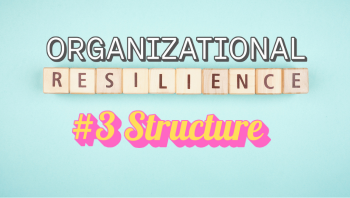Resilience-Dimension 3: Structures
This article shows why flexible, network-like structures are the key to resilience and performance in a multi-crisis environment.
Why hierarchies are dangerous in times of crisis and network structures are the future
In the debate about the best organizational structure for companies, administrations, and even sports teams, loud voices are once again calling for a return to classic hierarchies and “strong leadership.”
The mistake here is to believe that the choice of organizational structure is based on personal preference or the spirit of the times.
We believe this is an illusion: the decision on the best organizational and process structure should be based solely on the company's strategy. This strategy must provide an answer to the key internal and external requirements. One of the dominant requirements for the future is to make the organization resilient – through the consistent development of all elements of the management system.
This article shows why flexible, network-like structures are the key to resilience and performance in a multi-crisis environment.
Principles of resilient organizational structures
A resilient organizational structure is the opposite of a rigid hierarchy. It is flexible, adaptable, and enables rapid responses to change.
1. Decentralized decisions for greater agility
In a fast-paced world, decisions can no longer be made at the top alone. Information is at the grassroots level, with teams that interact directly with customers, markets, and technologies. Delegating decision-making authority speeds up processes and strengthens employee engagement.
2. Promote autonomy and delegate responsibility
Autonomous teams are at the heart of resilient structures. Trust replaces control, and a more advanced leadership culture becomes crucial to achieving the necessary ability to act.
3. Build redundancy for robustness
Redundancy protects the organization against failures. Key competencies are distributed, supply chains diversified, and overlapping skills promoted—not as waste, but as a buffer.
4. Establish fast and transparent information flows
Open communication channels and digital technologies promote knowledge sharing and transparency. Self-directed access to relevant information becomes a core competency.
From organizational chart to living organism: transformation into a network structure
The transformation from rigid hierarchies to flexible network structures is challenging but necessary.
- Establish autonomous teams: Form small, interdisciplinary teams with full responsibility for products, projects, or core processes – inspired by successful models such as Spotify or Haier.
- Clearly define roles and responsibilities: Even in flat hierarchies, clarity is essential. Precise role descriptions prevent overlaps and ensure effective collaboration.
- Promote cross-functional collaboration: Break down silos, strengthen exchange between departments and management levels, and actively shape the changing role of leadership.
- Implement digital collaboration tools: Digital platforms and tools create the technical basis for networked ways of working.
Step-by-step transformation through pilot projects
Start with small pilot areas, gather experience, and then scale up.
Leadership in a network: Rethinking the role of managers
Managers become enablers, coaches, and architects of an environment in which employees can develop their potential.
- Build trust: Give teams autonomy.
- Set the direction: Clear goals instead of micromanagement.
- Remove obstacles: Provide resources and promote collaboration.
- Model a learning culture: See mistakes as opportunities and encourage experimentation.
Develop your organizational structure in a practical way
- Analyze decision-making processes: Identify bottlenecks and remove obstacles.
- Launch pilot projects for autonomous teams: Select areas, set clear goals, and give people freedom.
- Establish agile coordination formats: Regular check-ins instead of rigid meetings promote the flow of information.
- Expand communication platforms: Internal networks and wikis support transparency and collaboration.
- Prepare managers for new roles: Training and coaching for a culture of trust and delegation.
Conclusion: Network structures as the key to resilience
The multi-crisis is forcing organizations to rethink their structures. Rigid hierarchies are a thing of the past.
Clarify your strategy, formulate concrete goals, and choose an organizational form that enables resilience, performance, and health for your employees.
3 ideas for your organization:
✅ Decentralized decision-making and autonomy increase agility and commitment
✅ Network structures with clear roles promote cooperation and resilience
✅ Leadership as an enabler creates the basis for sustainable transformation
Reflection question:
Which of these fit your organization—and where could you take the first step?


About me

All Rights Reserved
Get in touch
-
+49-(0)941 600 93 003
-
This email address is being protected from spambots. You need JavaScript enabled to view it. -
Thomas_Huber
ToChange Gmbh
-
Thomas Huber
-
Traubengasse 6
-
D-93059 Regensburg

